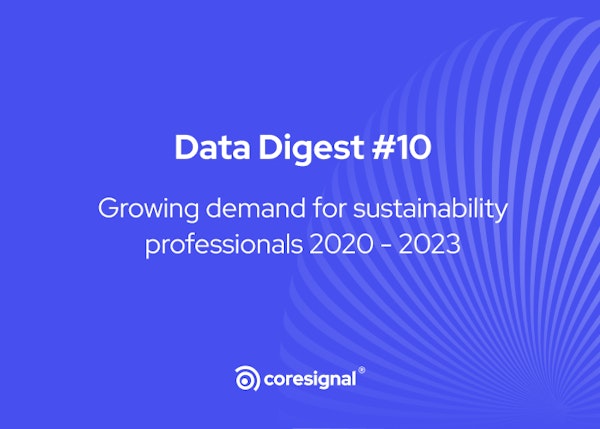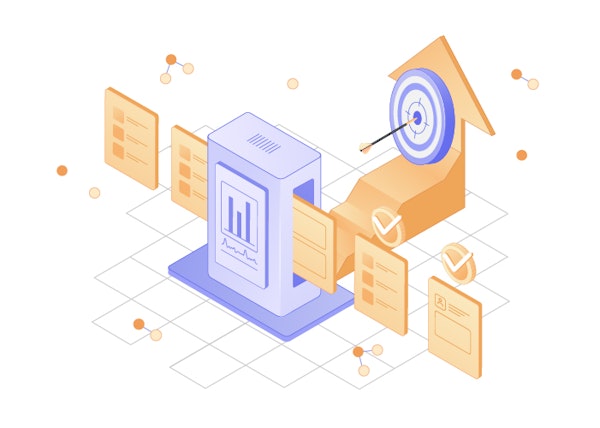Professional network data
Leverage our top B2B datasets
Job posting data
Get access to hundreds of millions of jobs
Employee review data
Get data for employee sentiment analysis
Clean dataNEW
Enhanced professional network data
Employee data
Get data on global talent at scale
Funding data
Discover and analyze funding deals
Firmographic data
Unlock a 360° view of millions of companies
Technographic data
Analyze companies’ tech stacks
BY INDUSTRY
MOST POPULAR USE CASES
Investment
Leveraging web data for informed investing
HR tech
Building or enhancing data-driven HR tech
Sales
Supercharging your lead generation engine
Marketing
Transforming marketing with web data
Market research
Conducting comprehensive market research
Lead enrichment
Use Coresignal’s data for enrichment
Talent analytics
Analyze talent from multiple perspectives
Talent sourcing
Comprehensive talent data for recruitment
Investment analysis
Source deals, evaluate risk and much more
Target market analysis
Build a complete view of the market
Competitive analysis
Identify and analyze competitors
B2B Intent data
Lesser-known ways to find intent signals
BY INDUSTRY
MOST POPULAR USE CASES
Investment
Leveraging web data for informed investing
HR tech
Building or enhancing data-driven HR tech
Sales
Supercharging your lead generation engine
Marketing
Transforming marketing with web data
Market research
Conducting comprehensive market research


Coresignal
November 15, 2021
Nowadays, every business professional has come to an understanding that data is key to business performance. Yet, data intelligence is broad, and so are data sources and types. Intent data is a specific type of information that can help you shape your competitive advantage. It creates a strong pipeline of leads, so your sales team can direct all of their efforts to expanding market share and attracting more customers.
The following sections introduce you to everything you need to know about intent data, its benefits, sources, and how to leverage it to obtain customer insights.
What is intent data?
Generally speaking, B2B intent data is a type of information that refers to how users behave online, or how they consume online content. In other words, intent data shows your users’ interests, so you will be able to predict their interest in your products and services, targeting your potential customers more efficiently.
First of all, B2B intent data could show you which users may be interested in your company’s offerings. Consequently, they are closer and more likely to make a purchase decision. As a result, you can leverage this information to target these people via your personalized marketing campaigns.
Secondly, B2B intent data consists of anonymous online data, but the concept is broader and has already been used by businesses for many years. Outside the virtual environment, intent data is collected via event participation, body language observation, and mail engagement. In the digital era, intent data is now collected via online chat interactions, social media activity, and web content consumption patterns.
Finally, B2B intent data can be used to understand how customers think, what their buying journey is, and what they are likely to do next on the web. When used by marketers and sales team, intent data helps to understand several aspects:
- What content users are interested in;
- What topics are researched online;
- What solutions or needs customers seek to fulfil;
- How users interact with different websites.

Types of intent data
In general, intent data can be sub-categorized into two groups: first-party data and third-party data (public web data)
First-party intent data
First-party intent data is internally collected information. For instance, if your business has a website, you can easily collect first-party intent data. This may include application logs, how users interact with your website, which sections are most accessed, how long they stay on the website before buying the product, and how many of your users actually end up buying your products.
First-party intent data is useful for your business; however, it is also limited since you may want to expand your offering to other potential buyers. This only offers you an insight into your existing customers’ needs, preferences, and buying behaviors.
Third-party intent data (public web data)
Third-party intent data is external; this is collected via web scraping, or gathered by publisher network, user registration procedures, or cookies. This public web data is richer compared to internal intent data; for instance, collecting data from websites shows you what comments users leave, what types of content they seek or download, what they search for on websites, and more.
This type of data is only available through (third-party) data providers which help businesses understand the total interested market. There are endless use cases of third-party intent data, including targeted advertising campaigns and content personalization.
Intent data is one of the fastest-growing data types in the past years. It changes how marketing and sales teams work. According to this market guide, 90% of companies that purchase intent data use it to prioritize customers.
Firstly, B2B companies use technographic or firmographic data to identify and prioritize clients. Then, they use this information to customize the sales messages. Up to 52% of companies purchasing intent data from a data provider use it for sourcing leads, while 46% of businesses use it to create an ideal customer profile.
Secondly, using multiple data types from the same data provider is quickly becoming the standard. Up to 54% of current intent data users plan to maintain their spending habits, and up to 43% plan to increase their data consumption.
Finally, up to 58% of current non-users plan to purchase intent data. To put it into context, at least half of your competitors that do not source data from a DaaS company may be currently planning to purchase such datasets to improve their performance.
Best sources of intent data
Businesses with an online presence already know how to access and use visitor data. But, the most important intent data does not come from your own website. In fact, companies use B2B intent data to attract buyers before they even access the website for the first time.
The main reason is that almost the entire pre-purchase research process is done online. For example, Google states that up to 89% of buyers do online research before they move on with a purchase. In other words, web searches are a strong signal of user intent before they engage with a sales representative. In other words, most buyer activity takes place on websites other than yours, so having access to intent data is crucial for demand generation strategy.
How is buyer intent data collected?
The easiest and most convenient way of collecting B2B intent data is by buying from a data provider. These DaaS (Data-as-a-Service) companies collect data from social media platforms and websites, aggregate the online research activity, and present it to you in a readable, easy-to-understand format. DaaS providers use countless B2B websites, social media platforms, and media publishers to collect information.
In turn, your company can interpret these datasets to obtain detailed insights into the type of content consumed, the average time spent on websites, number of users, and scroll speed. This helps you identify and take advantage of opportunities, expanding your business reach by targeting the customers at the right time throughout their research journey.

Intent data use cases
Intent data can be extremely broad and detailed, so it comes with abundant opportunities for businesses in all industries. Let us see how you can use B2B intent data according to its source.
Internal intent data (first-party data) collected by your company can be leveraged in several ways. Some of the main ones include:
- Engaging the customers at the right time. Using internal data means that you can get an insight into the user’s online journey. You can then set automated triggers in the marketing automation system to engage the user at the right time, enhancing the chances of making a purchase decision on your website or getting the user to engage with a sales rep.
- Understand your priorities. Not all online users visit your website with the intent of purchasing your products or services. Internal intent data can show you the user’s likelihood of buying soon, so your sales team can make the difference between users with real purchase behaviors and cold prospects.
- Nurture your customers. Intent data help you understand which ones are your repeat customers, so you can target them differently. You can then nurture them, enhancing re-engagement and securing repetitive purchase patterns.
- Identify successful campaigns. Not all of your marketing efforts are successful; internal intent data help you understand where you are falling short, so you can keep improving your marketing campaigns and content to drive sales.
Intent data sources from external data providers (third-party data) also come with numerous benefits, especially if you want to attract new customers. Although focusing on your existing website users is important to maintain your customer base, attracting new leads is crucial for business performance and expansion.
- Find out who is interested in your offering. Using third-party data providers allows you to understand which online users are interested in your products and services. Then, you can use personalized emails or marketing campaigns to attract them to your business.
- Targeted advertising. Third-party intent data show more than who is interested in a specific product. You can use this information to understand device usage and internet consumption patterns. As a result, you can figure out the most efficient marketing channels.
- Enlarge your scope. By understanding online consumption patterns, you can find ways of expanding your product offerings or services, so you can attract new types of customers, boost your R&D efforts, and keep gaining market share.

Benefits of intent data
What are the benefits of using B2B intent data?
The numerous use cases for B2B intent data come with sound business advantages. Below, you will find out some of the most important ones.
Focusing on active customers
When dealing with the online world, sorting through active and inactive users can be a daunting task. Knowing which users are active and interested in your content can provide you with exceptional intelligence that allows you to use business resources more efficiently.
Once you identify your main customer base, you can prioritize them according to the stage in their purchasing journey. In other words, you can target people reaching the end of their search, providing them with solutions that boost your conversion rates.
Finding interested prospects
If you want to expand your customer base, you can use intent data to find users that exhibit interest in products and services similar to yours. This allows you to increase your lead pipeline and, eventually, boost revenues by attracting more customers.
Learn more about your target market
Finally, B2B intent data show insights into web content consumption patterns. In turn, this helps you understand your key audience – who these people are, what they need, and what their problems are. As a result, you can provide them with efficient solutions.

Conclusion
Businesses are quickly expanding their investments in data. Intent data shows what users consume across the web, so your business can use it to fuel marketing campaigns and personalize content, driving sales and customer conversion rates. When paired with other types of data, intent data can help you grow your business rapidly, strengthen your competitive advantage, and increase customer engagement and retention rates.
Don’t miss a thing
Subscribe to our monthly newsletter to learn how you can grow your business with public web data.
By providing your email address you agree to receive newsletters from Coresignal. For more information about your data processing, please take a look at our Privacy Policy.

Related articles

Sales & Marketing
It’s a (Data) Match! Data Matching as a Business Value
With the amount of business data growing, more and more options to categorize it appear, resulting in many datasets....
Mindaugas Jancis
April 09, 2024

Data Analysis
Growing demand for sustainability professionals 2020 - 2023
Original research about the changes in demand for sustainability specialists throughout 2020-2023....
Coresignal
March 29, 2024

Data Analysis
Refined Data as a High-Value, Low-Maintenance Option
Raw data refinement is a vital step before delving into the analysis. But should all companies do this by...
Coresignal
March 28, 2024